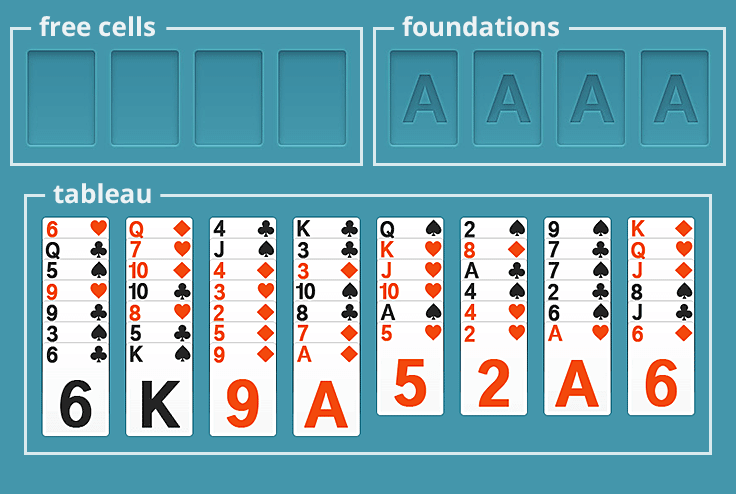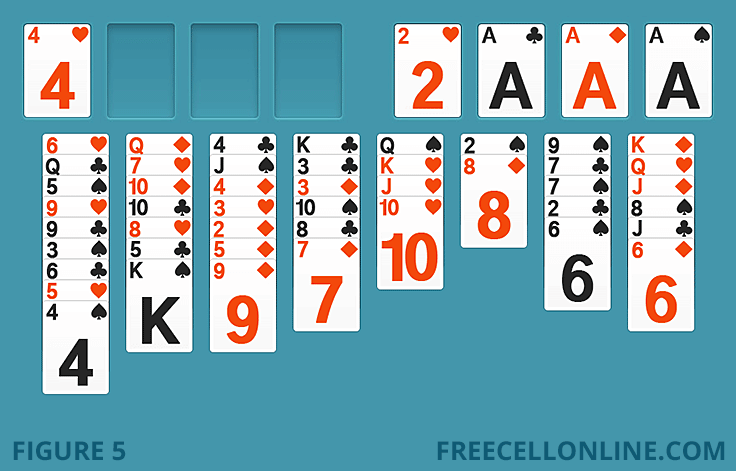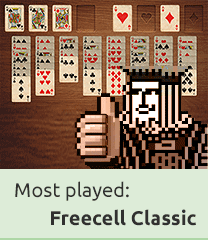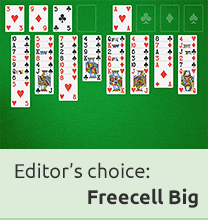Freecell Solitaire Rules
If you're new to Freecell or struggling to win even one game, we recommend following the instructions on this page. In this tutorial, we will demonstrate how to solve a given game number so that you can play along with us. You can enter these game numbers into most of the online games on our website.
The playing field
 To get a good understanding of Freecell, we will start by looking at the layout, which consists of three parts:
To get a good understanding of Freecell, we will start by looking at the layout, which consists of three parts:
The "free cells": these are the 4 free cells in the top left corner, where you can temporarily park cards.
The "foundation": in the upper right corner of the screen, you'll find the 4 foundations, which serve as the final destination for all tableau cards.
The "tableau": this is the part where 52 cards are laid out face-up. The cards are divided into 8 columns. The first 4 columns have 7 cards each, and the last 4 columns have 6 cards each.
The goal of the Freecell game
The goal of Freecell is to strategically move all tableau cards to the 4 foundation piles. Here they are placed in order from low to high (ace to king), neatly sorted by the 4 different suits of the card game. You will have a hearts pile, a spades pile, etc. To achieve this, players should focus on moving low-ranking cards first, starting with the aces, followed by twos and then higher cards. When arranging the tableau, the cards should be sorted in descending order and alternating color (red and black).
How to play a game of Freecell, step by step.
 In this Freecell tutorial, we will be using game number 3148. As previously stated, the cards on the tableau should be arranged from low to high (ace to king), which means we begin by searching for the lowest cards, the aces. As you can see in figure 2, we have two Aces face-up in columns 4 and 7. We select one of the Aces, and the game will automatically move them both to the foundation. The game also moves the 2 of hearts from column 6 to the foundation since this card is open (not obstructed by any other card) and fits on the ace of hearts. Our first three cards have been successfully moved to the foundation:
In this Freecell tutorial, we will be using game number 3148. As previously stated, the cards on the tableau should be arranged from low to high (ace to king), which means we begin by searching for the lowest cards, the aces. As you can see in figure 2, we have two Aces face-up in columns 4 and 7. We select one of the Aces, and the game will automatically move them both to the foundation. The game also moves the 2 of hearts from column 6 to the foundation since this card is open (not obstructed by any other card) and fits on the ace of hearts. Our first three cards have been successfully moved to the foundation:
 Our search for low cards continues. In column 5, we see the ace of spades, but it is blocked by a 5 of hearts. Fortunately, we can move this 5 to the 6 of clubs in column 1, which triggers an automatic play of the Ace of spades to the foundation:
Our search for low cards continues. In column 5, we see the ace of spades, but it is blocked by a 5 of hearts. Fortunately, we can move this 5 to the 6 of clubs in column 1, which triggers an automatic play of the Ace of spades to the foundation:
 Free cells
Free cells
Now we are going to use the free cells. As you can see in figure 4, the last ace is located in column 6 and is blocked by a red 4 and a black 4. We cannot place the red 4 on any other card in the tableau since there is no open black 5, so we will move it to one of the free cells. After that, we move the black 4, which also blocks the ace, to the red 5 in column 1, and another ace is freed:
 Empty columns
Empty columns
We continue our search for other low cards. As you can see in figure 5, there is a 2 of spades in column 6. We move the 8 that is blocking it to a free cell and the 2 is automatically moved to the spades foundation. We notice something new here, there is now an empty column in the tableau:
 These empty columns are very useful because you can place any card on them, so they can serve as an additional free cell. In Freecell, it is important to have as many empty free cells and columns as possible so that you can make power moves. We will elaborate on this.
These empty columns are very useful because you can place any card on them, so they can serve as an additional free cell. In Freecell, it is important to have as many empty free cells and columns as possible so that you can make power moves. We will elaborate on this.
Power moves
In Freecell, "power moves" or "super moves" are useful shortcuts that allow players to move a series of cards in a single move instead of multiple separate moves. The number of cards you can move depends on the number of available free cells and empty columns. Empty columns are particularly valuable, as the more empty columns and free cells you have, the bigger the series of cards you can move.
Why not try it out for yourself? Take the black 8 from column 4 and move it to the red 9 in column 3. You will find that you can now move multiple cards at once, thanks to the presence of multiple free cells and columns:
 We have gotten you started on your way, and now you are all set to continue on your own. Look for the low cards and clear the playing field. Good luck!
We have gotten you started on your way, and now you are all set to continue on your own. Look for the low cards and clear the playing field. Good luck!



